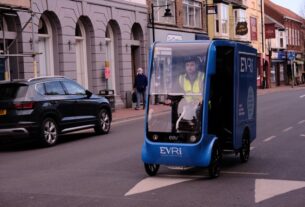The logistics industry is taking unprecedented measures to limit its impact on the environment. The drive to NetZero is becoming something everyone is involved with from managers to government. We spoke to Denise Beedell, Logistics UK’s Public Policy Manager, about how the UK government can further support the industry when it comes to achieving NetZero and why the organisation believes the current support does not go far enough.
Read more from the latest edition of The Logistics Point Magazine below:

Where are we now when it comes to achieving our NetZero targets?
Well, that depends on which sector you are talking about. The road sector has probably moved further than any other at the moment. There has been a huge take up with cars but from a logistics point of view, it’s mainly with light vans that initial progress has been made, but it’s really very early days. There are some manufacturers that are now bringing zero emission lorries to market, but, they tend to be at the lighter end. We’ve still got some way to go for the heavy, really heavy goods vehicles.
Is this based mostly on what the market can offer in terms of technological capabilities?
Yes, but it isn’t just about the technology of the vehicles, that’s part of it. There are some more fundamental things that need to be looked at before looking acquiring the vehicles. The key point is about the refuelling network.
Logistics UK is completely neutral about what technology is used, and if anything, we believe that we’ll probably need a range of technology solutions across the whole of the industry. There will be different routes to NetZero for different modes and different types of operations. But regardless, we need to ensure the infrastructure can support the move to decarbonise logistics operations. Take electricity, for instance. It’s actually fairly straightforward for most vans to move to electric for the majority of operations, but some will still find it very hard to electrify, like those who use their vehicles 24/7 or those that operate off-grid in very remote locations.

Before operators start buying the vans, they need to make sure that they know where vehicles will be charged. If operating from a depot, then that will be less complicated but there are still a lot of elements to consider. Things like how much space is available for vehicles while they are charging, how many hours a day are the vehicles in operation and ultimately, can the electricity supply at the depot support charging needs.
What is being done at the moment?
National Grid and energy suppliers, have confirmed there will be sufficient electricity supply to cope with the NetZero demands and I’m sure a lot of work is underway behind the scenes. There are also things logistics companies can do to help themselves.
We’ve seen some of our operators utilising old electric vehicle batteries to provide a source of additional energy supply. Others are using solar panels on their depot and warehouse roofs or utilising vehicle to grid technology (V2G) to manage energy supply costs. There are lots of technologies out there that are starting to emerge, but there aren’t any obvious winners just yet. It can be more challenging if you do not own your premises and your landlord imposes conditions that restricts what can be installed. And planning regulations can also add more hurdles, depending on location and property usage. If you have vehicles that don’t come back to the depot, then you need to think about installing charging facilities at employees homes. But if they do not have off-street parking or only have space for one vehicle, they may prefer to use that space for a personal vehicle instead.
So for vehicles that are taken home, it’s important that the public charging infrastructure is fit for purpose and will allow usage by commercial vehicles. Local authorities are largely responsible for installing public charge points, but their focus has mostly been on access to public charge points for private cars. This focus needs to change so that commercial vehicle needs are also recognised.
Why do you think the UK government is not providing enough clarity on the NetZero strategy?
There is a broad framework in place, but more detail is required by the sector to support investment decisions. It’s important that the various vehicle trials being planned, move quickly to large scale studies. At the recent ITT Hub Future Logistics conference in May, Trudy Harrison MP, the Minister for Transport announced £200 million to expand the trials. And we totally welcome this additional funding.
This research is important because operators need to have confidence that the charging network is actually going to be available for use by all vehicles that are likely to need to use the public charging network. We need to future-proof the infrastructure too; for example ensuring the power cabling in the ground is installed ready for chargepoint provision for heavier goods vehicles.
The other big elephant in the room is the regulatory system. The quest for greater mileage range will mean heavier vehicles which can eat into load carrying capacity.
If you are a parcel delivery company or you’re in the construction industry and your load carrying capacity reduces, then the only solution may be to put extra vehicles on the road. Currently a diesel vehicle is quite efficient in how much load it can carry before it needs to be refuelled.
Logistics UK is calling for a fundamental reform of vehicle regulations including weight thresholds. From 2030, we start to see new diesel and petrol vehicles sales phased out and there needs to be recognition that new zero-emission vehicles will be heavier than current conventionally fuelled vehicles.
The ambition is to ensure sufficient infrastructure is in place for fleets, that load carrying capacity is not reduced so operations become less efficient and the number of vehicle journeys increase, and that operators have the confidence to invest in new zero emission fleets to meet net zero targets.


